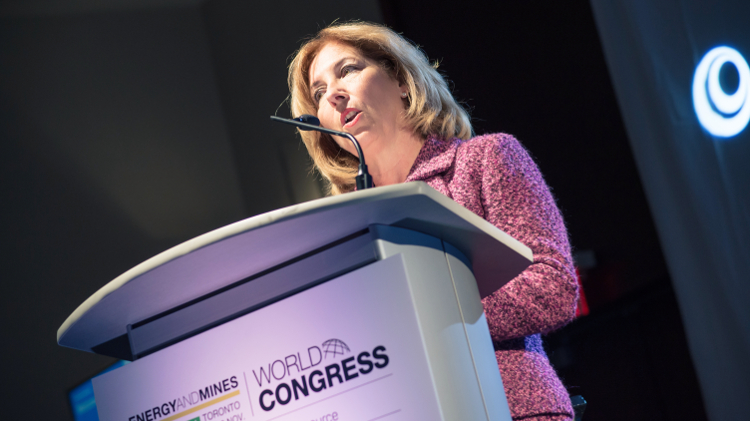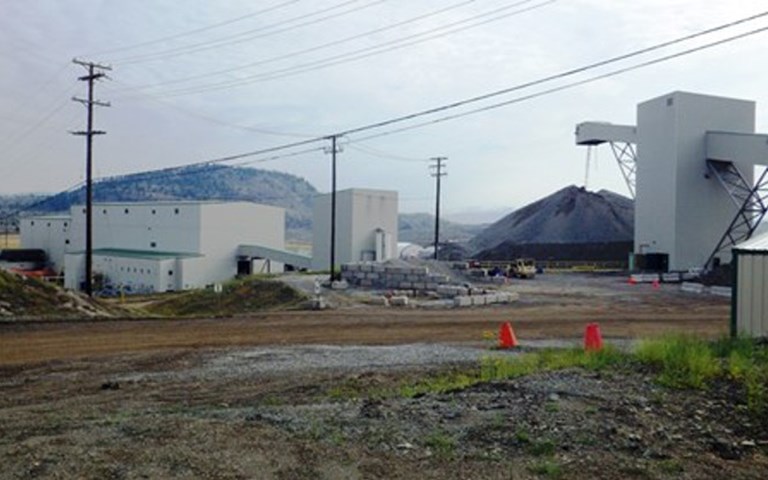New Afton has upgraded its flotation blowers, relocated underground compressors and is preparing to install ventilation on demand. All of these projects save energy and lower the mine’s environmental impact | Courtesy of New Gold
New Gold’s New Afton copper-gold mine recently became the first in North America to become certified under the ISO 50001 standard, which provides a new framework for improving energy efficiency. Putting an energy management information system (EMIS) in place helped form the foundation for the implementation of the standard. The mine, located near Kamloops, B.C., went into production in June 2012 and achieved standardization on March 31 of this year with $22,050 help from Natural Resources Canada (NRCan).
There are many reasons to improve energy efficiency, not the least of which is profitability. “Energy is a big expense for us, so any improvement in efficiency contributes to the bottom line of the company,” says Andrew Cooper, energy specialist at New Afton.
“We wanted something that would be long term and self sustaining,” adds Cooper. “It’s one of the reasons we decided to pursue ISO 50001 certification. It sets up systems and processes that will be a part of the culture of the organization.”
NRCan support
The Canadian government is equally motivated in investing in programs that help businesses become more energy efficient, and that remove barriers that hold them back from making energy-efficient choices, says Bob Fraser, chief of engineering support services for NRCan. One such program is NRCan’s ecoENERGY Efficiency for Industry, which provides cost-share assistance to businesses implementing an energy management system, such as that required by ISO 50001. The assistance matches funding from the company up to $40,000 and helps cover professional fees, training costs and salaries, amongst other things.
New Afton is the first mine to take advantage of the program, and the addition of the mining sector is an important development, says Fraser: “Mining is one of Canada’s most important economic sectors and is a major contributor to our country’s prosperity. It is also a high-energy use sector, accounting for over 30 per cent of industrial energy use, and therefore presents considerable opportunity for energy savings. The potential for energy management systems to reduce energy consumption in this sector is too great to be overlooked.”
According to Fraser, companies that have implemented ISO 50001 are seeing energy savings of five to seven per cent annually in the initial years of the program. Of note, he says, is where the savings are coming from. “A recent study in the United States indicates that 75 per cent of the savings are the result of operational projects,” he points out. “These are no-cost or low-cost projects affecting how the plant is operated, such as turning off equipment when it is not in use.”
New Afton is already seeing the same thing. “We’ve had an initiative where the crews just started shutting down conveyor belts at certain times when there was no load on them,” says Cooper, citing an early example. “That’s just operational and has no capital cost whatsoever, and it’s saving us a huge amount of money.”
Still, the mine does have other energy improvement projects underway that require more investment. “We’re installing ventilation on demand, and that project is costing us in excess of half a million dollars,” says Cooper. “Fortunately there are organizations like NRCan, BC Hydro, FortisBC and the Ontario Power Authority, which offer incentives to help make projects like this much more attractive from a capital perspective.”
The ventilation project is expected to save New Afton around 7.5 gigawatt hours (GWh) of energy a year. It is the third major energy efficiency project in a year. An underground compressor relocation is saving the company 1.3 GWh a year, and a mill flotation blower upgrade is saving in excess of 1.4 GWh a year.
Previously, New Afton employed four compressors for the underground air supply, each operating independently at various places around the mine. The relocation project brought three of these into a centralized compressor building. They also installed a large air receiver and installed energy, pressure, temperature and flow monitoring, and compressor control set points. The new system runs one compressor full time, with two others running as demand requires.
New Afton also installed proportional control on the mill’s three flotation blowers, two of which previously ran full-time, blowing off excess air – something Cooper says was both noisy and a waste of energy. The blowers now only supply the air required by the flotation process.
But the benefits go beyond energy savings. “All of the projects we’ve done so far have had an operational benefit, environmental benefits and safety benefits,” says Cooper. “So even though we’re improving efficiency, we’re actually improving the process at the same time. It’s a great match: everything you do helps to contribute towards improved performance of the facility.”
Systems more important than one-offs
Cooper suggests that, while the projects are important to improve efficiency, there is a need for a system-based approach to energy management. His focus is on implementing a system of continual improvement.
ISO programs integrate a system of continual monitoring of energy consumption, along with an increased awareness of energy use, into the mine’s operations. “You pick up things that aren’t working properly, and you make improvements,” says Cooper.
The systems approach does not work without robust numbers, he explains: “You need good data in order to measure and assess whether something is performing well or not, and to quantify and estimate the savings – and then once you’ve completed a project, to verify those savings.”
For all of this, New Afton brought in RtTech, which works with companies to set up an EMIS. According to CEO Pablo Asiron, some of RtTech’s clients have reduced energy costs by 6.6 per cent using RtTech’s industrial EMIS software, RtEMIS.
“The key of an EMIS system is to be able to calculate at target,” says Asiron. “In the case of our product we use historical data to build models to calculate how much energy a piece of equipment – a conveyor belt, or a crusher – should be using. And then we compare the actual energy consumption to the target, and that’s how we are able to detect periods of time where the efficiency is below where the model says it should be.” Essentially, he says, an EMIS system allows you to find the low-hanging fruit.
Submetering helps break energy use down
“If you want to improve the energy efficiency in your plant or reduce the energy usage, the first step is to measure and visualize the energy usage across the plant,” says Asiron, including when, where and how energy is being consumed. This is achieved through a network of meters that measure the rates of energy consumption of equipment or grouped equipment areas.
“The installation of the submetering is a key component to EMIS,” says Cooper, “as is getting the data from that submetering back to one point, where you can store it. That forms the foundation for everything. Once you have the data, you need a system in place to help you view, utilize and report on that data.” New Afton installed 157 electrical submeters and six gas meters throughout the facility, including around the mill, the mine, the crushing and conveyor systems, and surface facilities.
As much as an EMIS is driven by raw data, it is also powered by people, according to Cooper. “At the end of the day it’s not ISO 50001 that manages energy, its people,” he says. Creating a culture of energy awareness, he suggests, may be the most significant aspect of the energy management program.
New Afton encourages employees and contractors to make suggestions regarding energy use and future energy improvement projects. “A huge percentage of projects we undertake have come about as suggestions from employees,” says Cooper. He organizes awareness campaigns and reports on energy performance at weekly meetings. “We also have systems and procedures in place to make sure we procure goods and services that are energy efficient. And we look at the life cycle cost of those purchasing decisions. It’s really a multi-layered approach on all levels of organization.
“It’s the small things,” he adds. “People are thinking about energy on a day-to-day basis.”




